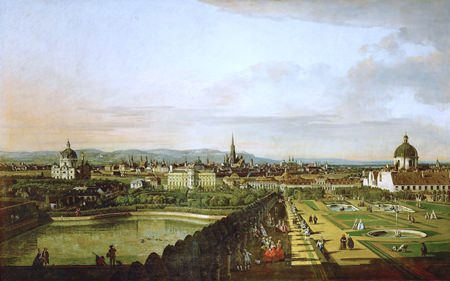
Right, let’s start with a test. I’ll give you a list of composers and we’ll see how many names you recognise. Here it is: Adalbert Gyrowetz, Johannes Matthias Sperger, Dmitry Bortniansky, Leopold Kozeluch, Etienne Ozi, Justin Heinrich Knecht, Artemy Vedel and Johann Georg Lickl. Ring any bells? Unless you have a special interest in music of the late eighteenth century, their names are possibly meaningless. But don’t feel inadequate, because few professional musicians today have ever heard of them.
The composers in the list were born between the years 1750 and 1770 and were therefore contemporaries of Mozart. Wikipedia lists nearly two hundred other composers who were born during the same twenty years but there were probably many more.
They may seem an obscure bunch today, but in their time they were celebrities in the musical world. Take the curiously-named Adalbert Gyrowetz for example. He spent much of his time travelling around Europe and wrote over thirty operas, sixty string quartets, sixty symphonies and about forty piano trios. He was born in the Czech city of Budìjovice, also known as Budweis and famous for Budweiser Bier which has been brewed there since the thirteenth century. Adalbert may well have had a few swigs of the amber nectar to encourage his creative flow.
You don’t hear much about Wranitzky these days either. He was born in the same year as Mozart and like Adalbert Gyrowetz, hailed from what is now the Czech Republic. Like many other Bohemian musicians of the time, he moved to Vienna which was then the most important cultural centre in Europe.
Wranitzky was a composer and conductor and highly respected by Mozart, Haydn and Beethoven. He was Beethoven’s favourite conductor and gave the premier of the first symphony in 1800. He was a prolific composer too and churned out forty-four symphonies, sixty or seventy string quartets and a couple of dozen operas and ballets. This might seem a disproportionate amount of self-inflicted hard labour, but there was an enormous demand for new music in Vienna and other cities. Unlike today, there was little interest in music written by long-dead composers. Towards the end of the nineteenth century, the French musicologist François-Joseph Fétis wrote, “The music of Wranitzky was in fashion when it was new, because of his natural melodies and brilliant style. I recall that in my youth, his works held up very well in comparison with those of Haydn.”
Oberon was of course the mythological King of the Fairies. Perhaps he still is. He was the subject of several operas, most notably the one written by Weber in 1826. This tuneful overture to Wranitzky’s opera is played on authentic historical instruments by an excellent baroque orchestra based in The Hague.
Hoffmeister was born two years before Mozart, and by the 1780s he’d become one of Vienna’s most popular and highly respected composers. He wrote at least eight operas, over fifty symphonies and a large number of concertos. He also established one of Vienna’s first music publishing houses, and published not only his own works but also those of many other major composers of the time, including Haydn, Mozart, Beethoven, Clementi, Albrechtsberger and Dittersdorf. These people were also among Hoffmeister’s personal friends and in one letter Beethoven evidently addressed him as “my most beloved brother”.
Hoffmeister wrote a great deal of music for the flute, presumably with Vienna’s growing number of amateur musicians in mind. The flute was one of the most popular instruments.
This concerto is one of Hoffmeister’s best-known works and one of the few that are still played. It was written in 1799 and cast in three movements which was the convention at the time. It’s scored for a modest orchestra of two oboes, two horns and strings. In those days, the symphony orchestra was only just beginning to emerge. There were strings of course and sometimes a couple of horns or a pair of flutes or oboes, but nothing like the standard woodwind and brass sections that are common today. Composers simply wrote for whatever instruments a particular orchestra happened to have.
This performance features an advanced student of the Escuela de Música Mozarteum in Caracas. Fabián Orozco gives an accomplished account of this joyful concerto which reflects the classical ideals of contrast, well-structured melodies, transparent textures and a sense of light elegance. The lyrical slow movement is an absolute delight.
The music of many lesser-known composers can be found on YouTube but listening to this concerto, I can’t help wondering how many hundreds of other forgotten voices are still waiting to be rediscovered.




